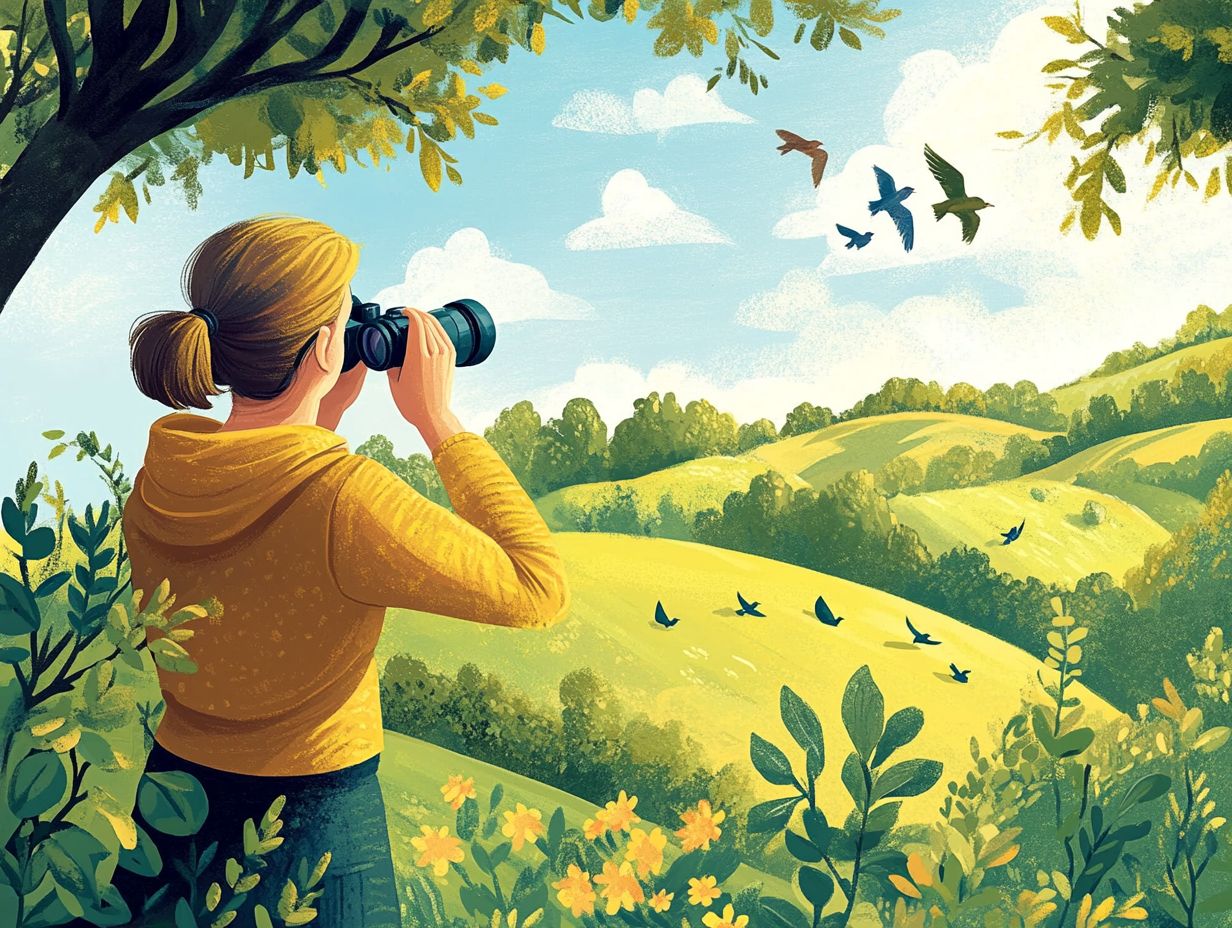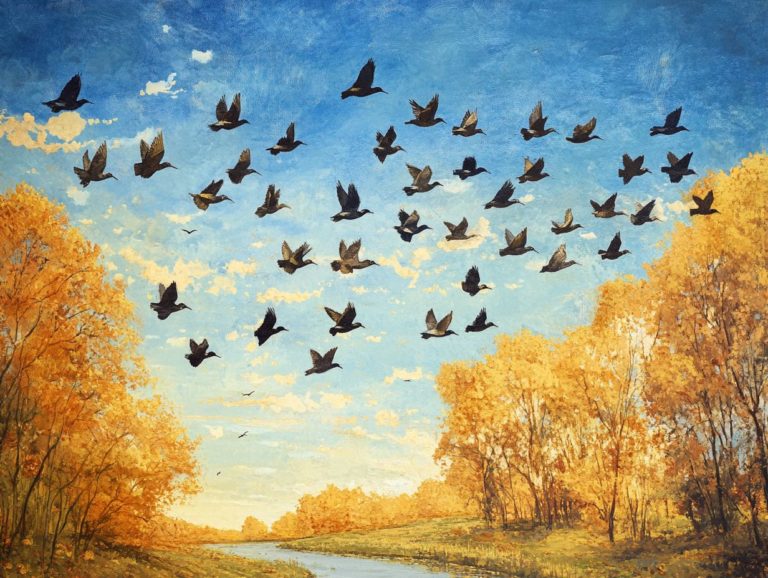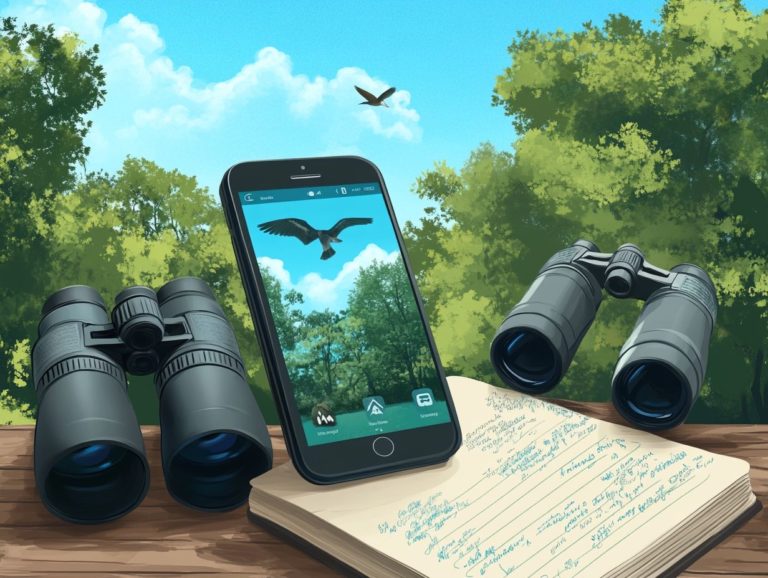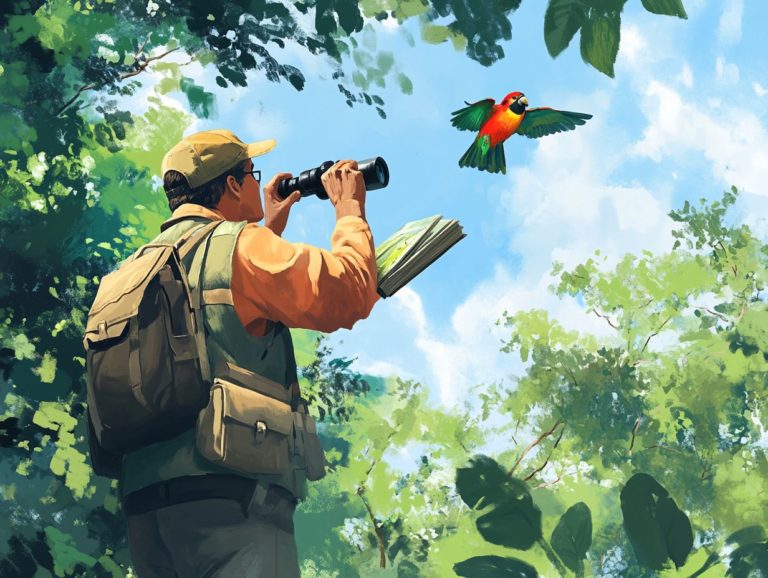How to Improve Your Bird Watching Skills?
Bird watching is a captivating hobby that connects you with nature. It deepens your appreciation for wildlife.
This popular pastime encourages patient observation and exploration of diverse environments, such as wetlands, forests, and urban parks.
Whether you re a bird enthusiast or just starting out, having the right tools can greatly enhance your experience.
This guide covers essential equipment, effective identification strategies, and tips for attracting birds to your space.
You ll learn how to document your observations and refine your skills. Start your exciting journey to become a skilled bird watcher today!
Contents
Key Takeaways:

- Choose proper equipment like binoculars and reliable field guides to enhance your bird-watching experience.
- Observe bird behavior and learn their calls to accurately identify different species.
- Create a welcoming environment to attract birds and research their habitats.
What is Bird Watching?
Bird watching invites you to immerse yourself in the art of observing and identifying various bird species. It fosters a profound connection with wildlife.
By observing birds in their natural habitats and noting their migration patterns, you can elevate your birding skills. Consider using apps to enhance your birdwatching skills and celebrate successes in this rewarding pursuit.
The thrill of spotting a rare bird or hearing a unique call can turn an ordinary day into an unforgettable experience. You’ll join a community rich with shared stories of local birding adventures.
As you identify different species, you ll sharpen your observational skills, which enrich your awareness of the ecosystem.
Engaging with nature highlights the importance of preserving natural habitats. Bird watching not only enriches your experiences but also strengthens bonds with fellow enthusiasts who share your passion for the avian world.
Essential Equipment for Bird Watching
To genuinely elevate your bird-watching experience, investing in the right equipment is crucial. This encompasses high-quality binoculars, dependable field guides, and cutting-edge birding apps that provide invaluable resources for both novice and seasoned birders.
The right outdoor clothing ensures comfort while enabling you to move stealthily and patiently observe in diverse habitats, from grasslands to coastal areas.
Binoculars, Field Guides, and Other Necessities
Choosing the right binoculars is essential for your bird-watching adventures. They allow you to get up close and personal with birds in their natural habitat whether you’re observing songbirds in bustling urban parks or spotting ducks gliding through wetlands.
When you pair your binoculars with a reliable field guide, like those by Audubon or Sibley, you can efficiently identify various bird species and gain insights into their unique behaviors.
Investing in high-quality optics is key, as they provide clearer images and superior light transmission, making it easier to pick out fine details. Pay close attention to magnification (how much closer you can see the birds), lens diameter, and field of view; these factors significantly impact your viewing experience. It s often beneficial to test several models to find the one that feels just right in your hands.
Incorporating field guides or birding apps into your routine can elevate your experience. For instance, the Merlin Bird ID app is a fantastic resource for beginners, helping you quickly match your sightings with accurate descriptions.
You might recall the exhilaration of identifying a Baltimore Oriole on a bright spring day, aided by a swift check of its call on your phone. This harmonious blend of technology and tradition enriches your connection with nature, making every outing a memorable one.
Identifying Bird Species

Identifying bird species demands not just a keen eye but also a solid grasp of identification techniques. This knowledge lets you spot and enjoy diverse birds by examining their physical traits, behaviors, and calls.
By observing birds in their natural habitats and paying attention to their migration patterns, you can elevate your birding skills and learn how to spot birds from a distance, truly celebrating your successes in this rewarding pursuit.
Techniques for Accurate Identification
Accurate bird identification techniques help you distinguish between species by examining their physical traits, behaviors, and calls. Mastering these skills not only elevates your experience but also deepens your connection with local bird communities.
Field guides become your critical allies, offering detailed illustrations and descriptions that help you distinguish between similar species. One effective approach is to compare the silhouettes and colors of birds in various habitats, noting how a bird s markings can change with the seasons.
Patience is essential; taking the time to sit quietly can lead to those magical moments of discovery, like witnessing a nesting pair of finches engaged in their charming courtship rituals.
Seasonally, migratory flocks can transform landscapes, turning a familiar park into a vibrant hub of activity come spring. The thrill of spotting a rare warbler amidst the chorus of songbirds reminds you that patience, combined with keen observation techniques, can yield truly unforgettable experiences.
So, grab your gear and get ready for an adventure in the great outdoors!
Optimizing Your Bird Watching Experience
Optimizing your bird watching experience means embracing effective birding tips and immersing yourself in outings that connect you with the vibrant birding community. If you’re looking to involve younger ones, consider exploring how to teach kids about bird watching. This fosters shared knowledge and deepens your passion for this rewarding hobby. Ultimately, bird watching not only enriches your personal experiences but also strengthens bonds with fellow enthusiasts who share your passion for the avian world.
By participating in local birding events, you have the opportunity to learn from fellow enthusiasts and explore diverse habitats. This enriches both your skills and your enjoyment of the activity, creating a more fulfilling experience in the great outdoors.
Tips for Finding and Attracting Birds
Finding and attracting birds enhances your bird watching experience. Use effective tips on how to prepare for spring bird watching to explore diverse habitats, such as urban parks and wetlands, where bird communities flourish. By practicing guidelines for observing birds responsibly, you’ll adopt a respectful approach to wildlife observation. Engaging with nature this way emphasizes the importance of preserving natural habitats and instills a sense of responsibility towards conservation efforts.
You ll also learn how to document your observations and continually refine your skills, leading to memorable bird sighting moments.
To entice a diverse array of feathered friends, consider setting up vibrant feeders filled with seeds, suet, and nectar specifically tailored to the tastes of local species. Cultivating a bird-friendly garden with native plants not only offers food and shelter but also enriches local biodiversity.
Seek out prime locations, such as nature reserves and coastal areas, where an abundance of species can lead to unforgettable sightings. Many bird enthusiasts share success stories of how their gardens transformed into lively sanctuaries, attracting delightful and unexpected visitors.
Remember, maintaining ethical practices like minimizing noise and keeping a respectful distance from nests is crucial for protecting nature.
Recording and Sharing Your Observations

Recording and sharing your observations stands as a cornerstone of birdwatching. It enables you to track your personal progress through a dedicated birding journal, while enriching the collective knowledge within the birding community.
By employing bird photography and sharing insights on various birding resources, you can inspire fellow enthusiasts and cultivate meaningful connections within this vibrant community.
Keeping a Birding Journal and Sharing Your Sightings
Keeping a birding journal allows you to capture your bird watching adventures in a meaningful way. By noting key information like location, date, and species observed, you foster a deeper appreciation for the birds and their unique behaviors.
Additionally, sharing these sightings with the birding community enriches your personal journey and contributes valuable data that supports bird conservation efforts.
To maintain an effective birding journal, include observations such as habitat conditions, weather, and the behaviors of the birds you encounter. Organizing your entries chronologically or thematically can help you track patterns over time. You might set aside sections for migratory species or compare the silhouettes and colors of birds in various habitats, noting how a bird s markings can change with the seasonal changes.
Join local birding groups or online platforms to exchange findings, report unusual sightings, and tap into the collective knowledge of the community. Participating in citizen science projects, which involve community efforts to collect data for research and conservation, highlights the importance of collaborative data sharing and can influence conservation efforts and policy-making.
Continuing to Learn and Improve
Keep learning! It’s the key to becoming an exciting and skilled bird watcher. For those looking to improve their skills, understanding best practices for bird watching enhances your knowledge and sharpens your birding skills, allowing you to refine your techniques and embark on rewarding birding adventures.
By tapping into various birding resources including insightful books, engaging online courses, and hands-on local workshops you can significantly enrich your ongoing journey of discovery.
Resources for Advancing Your Bird Watching Skills
A wealth of resources awaits you to elevate your bird watching skills. From comprehensive field guides and innovative birding apps to engaging local birding groups, these resources foster both learning and exploration. To enhance your experience, consider exploring what to look for in bird watching gear and transform your bird watching skills today!
Books like “The Sibley Guide to Birds” and apps such as Merlin Bird ID can significantly enhance your identification skills while providing valuable insights into bird behavior. Websites dedicated to birding offer essential information, including migration patterns and local sightings that can enrich your experience.
Joining local birding groups allows you to learn from seasoned enthusiasts and opens doors to organized outings. These excursions present opportunities to expand your knowledge base through shared experiences. Being part of a community can inspire and motivate you, as members engage together in the field, exchanging tips and anecdotes that elevate your overall birding experience.
Frequently Asked Questions

What is bird watching and why is it important to improve your skills?
Bird watching is the activity of observing and studying birds in their natural habitats. If you’re interested in this rewarding pastime, learning how to start bird watching as a hobby can enhance your skills and allow for a deeper appreciation and understanding of these magnificent creatures.
How can I improve my bird identification skills?
One way to improve bird identification skills is to study field guides and familiarize yourself with the physical characteristics, behaviors, and calls of different bird species. Additionally, knowing how to prepare for a bird watching trip can enhance your experience. Joining a bird watching club or group can also provide opportunities for learning from experienced birders.
What are some tips for spotting birds in the wild?
To spot birds in the wild, remain patient, quiet, and still. Pay attention to movement and listen for bird calls. Using binoculars can also help you get a better view of birds in their natural habitats.
How can I improve my bird photography skills?
To improve bird photography skills, understand camera settings and techniques, such as using a fast shutter speed to capture birds in flight. Practicing in different lighting and weather conditions can also help enhance photography skills.
Conclusion
Start your bird watching journey today! With the right resources and community support, you can enhance your skills and deepen your passion for this rewarding activity, while being aware of the challenges of bird watching.
How to Attract Birds to Your Backyard
Set up bird feeders and bird baths. Plant native plants to draw in a variety of birds.
Create a safe and natural space where birds feel at home.
Contributing to Bird Conservation
Join local birdwatching activities to help conservation efforts. Report your bird sightings to contribute valuable data.
Practice ethical birdwatching by staying on trails and respecting bird habitats.
Set up a bird feeder this weekend and enjoy the beauty of nature!






